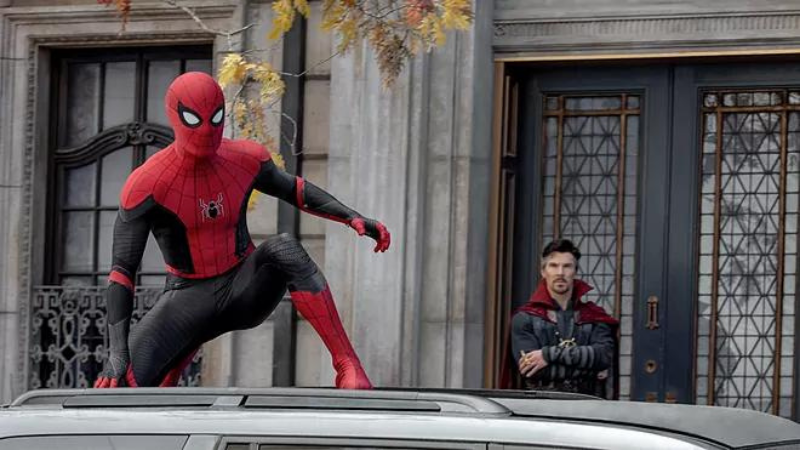Review: Spider-Man: No Way Home is a Christmas miracle
In the closing moments of Spider-Man: No Way Home, Peter Parker (Tom Holland), fresh-off the sewing machine, tries on his newest spidey-suit — a humble, tech-less, blue-and-red fabric without squinty, mechanised, expressive eye sockets, spider claws or living nano-machine gadgetry from his late godfather Tony Stark.
In most ways, it’s the character’s return home — an arrival to simpler times without the drama and nuisance of the digital age that has dogged the young pup’s dual identity since he debuted as Spider-Man in Captain America: Civil War back in 2016. This continued right until Spider-Man: Far From Home (2019), where he was unmasked to the world by the “supposedly good” villain Mysterio (Jake Gyllenhaal), in what was his vengeance after losing their climatic battle.
The end of No Way Home is almost a liberation: Peter is alone in a dingy apartment, reminiscent of the one another Peter Parker (Toby Maguire) lived in in his last two Spider-Man films, in another timeline (back when sequels only had numbers to distinguish them, and not fancy add-on titles).
It’s a visual cue of course, and one of the many negligible and wow-worthy spoilers sprinkled throughout No Way Home that the press, critics and the audience at large seem to be side-stepping because of a sudden global outflow of the Christmas spirit.
Almost no one is inclined to be the mean-spirited Scrooge from Dickens’ story by giving away details — most of which were deliberately slipped by studios Sony and Marvel in the trailer, or (Spoiler Alert!), one assumes from the hype about Maguire and Andrew Garfield making an appearance in this film.
To quote Dickens’ grouch: Bah, Humbug! The trailer gives it all away anyway.

Peter’s identity is compromised, so he begs Doctor Strange to wipe everyone’s memory. The spell backfires and opens a rift to other dimensions, pulling in Doctor Octopus, Green Goblin, The Sandman and Electro moments before their deaths.
The multiverse is Marvel’s trending story-convention since Avengers: End Game, and is now a prevalent trope running throughout their new phases in the Loki series, and upcoming films such as Ant-Man and the Wasp: Quantumania and Doctor Strange: The Multiverse of Madness (which presumably can have a narrative follow-up from No Way Home). Even Sony’s Oscar-winning blockbuster, Spider-Man: Into the Spider-Verse, dabbled in multiverses.
Screenwriters Chris McKenna and Erik Sommers, and director Jon Watts, are working on a well-oiled corporate machine, designed and run principally by Marvel head and master planner Kevin Feige. There are about a gazillion moving parts and story-threads, and sticking those together in a narrative that just works is nothing short of miraculous.
So, when Peter, in his new spider suit, jumps out the window in the Christmas snowfall, slides glibly on a snow-covered rooftop, with his foot piling up a snow hill, before hopping and hurdling through building tops, swinging over the New York skyline and then diving headfirst into the camera — where we see a split-second reveal of his face in the classic Spider-Man mask — we can appreciate, maybe even join, his sense of liberation and happiness, and the miraculous nature of No Way Home.
It is indeed a Christmas miracle — and I am not talking about the massive box-office this film was destined to become. The miracle is in the manner of storytelling.
No Way Home is the biggest fan-service moment in the history of motion pictures. In a single masterstroke, with Doctor Strange’s wayward spell, Marvel has done what no studio until now has even attempted: they’ve successfully bypassed legal hassles, sifted narrative pitfalls, added cohesion and legitimised all prior iterations of Spider-Man films (and Netflix’s Daredevil series) into a streamlined universe.
Hardly satisfied with that, Marvel went a step further by introducing dialogues that verified that those one-off universes didn’t end when Sony decided to stop producing the past two film series starring Maguire and Garfield.
The success of No Way Home is in its open-hearted embrace of every Spider-Man film in the continuity. No ego, no ill-will, just acceptance. The gesture alone makes the heart swoon.
So, No Way Home is a moment of calm and closure and giddy excitement. The story, miniscule as it is, is about Peter’s resilience and his sense of responsibility. When Doctor Strange asks Peter to round-up the stray villains from other timelines and send them back, he feels an obligation to help Dr Strange out. His actions spell out his life’s byword: with great power comes great responsibility — even if it’s not his responsibility to help out people who belong to past movies.
One doesn’t need to talk about No Way Home’s expensive production, its photo-real visual effects or the consistent and well-acted performances from the cast. It’s all there, from Alfred Molina’s drawling diction, Jamie Foxx’s indecisions, Thomas Hayden Church’s quiet composure to Willem Defoe’s cocky villainy. And, of course, the boys and the girls — Holland, Zendaya, Jacob Batalon, Benedict Cumberbatch, Jon Favreau and Marisa Tomei — shine as well.
With little to no directorial flourishes (I’m still not a fan of Watts; don’t really see his directorial individuality creeping out in the film), No Way Home stands shoulder to shoulder with Sam Raimi’s Spider-Man 2 as the best Spidey film ever. Maybe it will inch forward and take the top-spot in time…who knows. Will let you, the audience, decide after you go for a rewatch.
Released by HKC in Pakistan, Spider-Man: No Way Home is rated PG-13 for scenes of drama, dread and daredevilry
Originally published in Dawn, ICON, December 26th, 2021














Comments